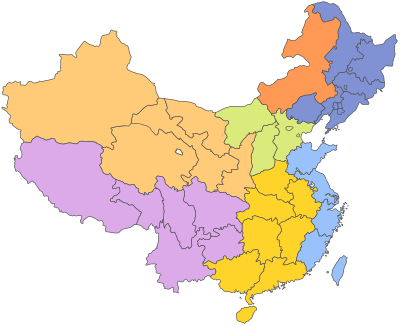Greater administrative area
Greater administrative areas (simplified Chinese: 大行政区; traditional Chinese: 大行政區; pinyin: Dà Xíngzhèng Qū) were early top-level administrative divisions of the People's Republic of China that directly governed provinces and municipalities. These were the largest-ever political divisions of China and were controlled by the Central People's Government. They were dissolved between June and November 1954.

List
The greater administrative areas originated from the districts governed by governors-general (simplified Chinese: 总督辖区; traditional Chinese: 總督轄區; pinyin: Zǒngdū Xiáqū) established during the late Qing dynasty. The six greater administrative areas were:
| Area | Chinese Simplified Traditional | Initial subdivisions | 1st secretary | 1st chairman | Capital | Creation | People's gov't creation |
|---|---|---|---|---|---|---|---|
| Huabei Area (North China) | 华北区 華北區 | Hebei, Shanxi, Chahar, Pingyuan, Suiyuan, Beijing, and Tianjin | Liu Shaoqi | Dong Biwu | Beijing | May 1948 | August 1948 |
| Dongbei Area (Northeast) | 东北区 東北區 | Songjiang, Jilin, Heilongjiang, Liaodong, Liaoxi, Rehe, Lüshun-Dalian, Shenyang, Benxi, Anshan, and Fushun | Gao Gang | Gao Gang | Shenyang | August 1946 | August 1949 |
| Huadong Area (East China) | 华东区 華東區 | Jiangsu, Zhejiang, Anhui, Fujian, Shandong, Shanghai, and Nanjing | Rao Shushi | Rao Shushi | Shanghai | January 1950 | |
| Zhongnan Area (Central and South) | 中南区 中南區 | Hubei, Hunan, Henan, Jiangxi, Guangdong, Guangxi, and Hankou | Lin Biao | Lin Biao | Hankou | February 1950 | |
| Xibei Area (Northwest) | 西北区 西北區 | Shaanxi, Gansu, Ningxia, Qinghai, Xinjiang, and Xi'an | Peng Dehuai | Peng Dehuai | Xi'an | January 1950 | |
| Xinan Area (Southwest) | 西南区 西南區 | Sichuan, Guizhou, Yunnan, Xikang, and Chongqing | Deng Xiaoping | Liu Bocheng | Chongqing | February 1950 | |
History
The highest officials of the greater administrative areas were known as chairmen (主席; zhǔxí). (From this historical origin derives the term still used today for the top officials of China's autonomous regions.)
North China Area was the first to be abandoned on October 31, 1949 when New China's capital was established in Beijing. The provinces it governed were thenceforth directly controlled by the North China Branch (华北事务部; 華北事務部; Huáběi Shìwù Bù) of the Government Administration Council of the Central People's Government instead. In May 1952, control was again transferred, this time to the North China Administrative Council (华北行政委员会; 華北行政委員會; Huáběi Xíngzhèng Wěiyuánhuì) of the Government Administration Council.
Several other large-scale entities governed parts of China's territory during this time and were equivalent to greater administrative areas:
- Inner Mongolia Autonomous Region
- Local Government of Tibet (西藏地方政府; Xīzàng Dìfāng Zhèngfǔ) i.e. (Kashag)
- The Executive Committee of Qiongyai Minority Nationality Autonomous Region (琼崖少数民族自治区行政委员会; 瓊崖少數民族自治區行政委員會; Qióngyá Shǎoshù Mínzú Zìzhìqū Xíngzhèng Wěiyuánhuì) from 1949, later assigned to Central and South China Area; the predecessor of Hainan
Except the Northeast, which was governed by a People's Government, the areas' highest government bodies were Military and Administrative Committees (军政委员会; 軍政委員會; jūnzhèng wěiyuánhuì), which were replaced by administrative councils in November 1952.
Several domains in China today retain the same structure of geographic divisions as the GAAs. Military administrative regions, the divisions of some major banks, and civil aviation districts are still divided in the same form as the greater administrative areas.